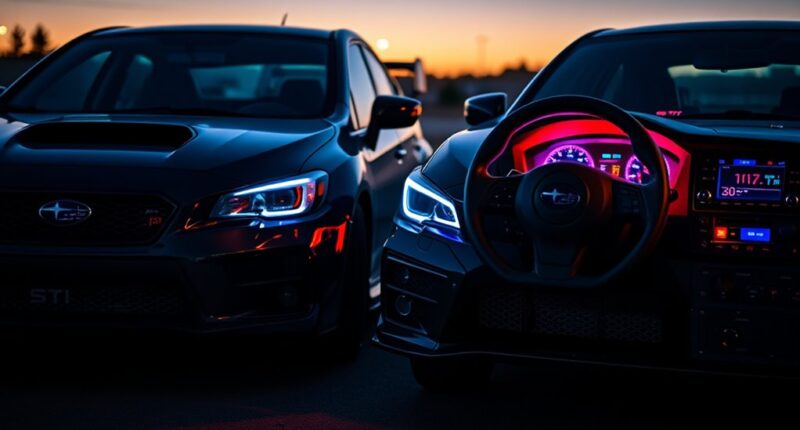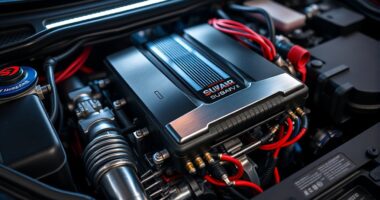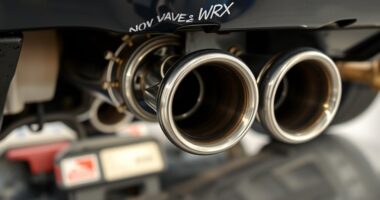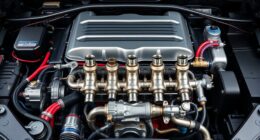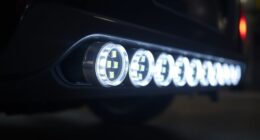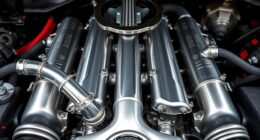If you’re looking for shift lights for your Subaru STI or Impreza, you’ll find both OEM and aftermarket options that can enhance your driving performance. OEM lights are usually integrated into the dashboard and offer basic alert features, while aftermarket units provide customizable RPM thresholds and adjustable brightness. Installation varies depending on your model year, but most require wiring into the tach signal and power circuits. Continue exploring to discover how to choose, install, and optimize your shift light for better driving control.
Key Takeaways
- OEM shift lights in 2015–2017 Subaru STI models are configurable via the dashboard, with factory RPM thresholds in some trims.
- Aftermarket shift lights cost between $50 and $300, requiring wiring into the vehicle’s tach or ignition circuits.
- Proper installation involves mounting in a visible area and wiring to the tach signal, ground, and switched 12V power source.
- Advanced options offer adjustable brightness, programmable shift points, and compatibility with manual or automatic transmissions.
- Troubleshooting common issues includes checking connections, inspecting wiring, and ensuring proper calibration for accurate shift alerts.
Overview of OEM Shift Light Features in Subaru Models

In Subaru models, OEM shift lights are designed to help drivers optimize engine performance by providing visual RPM alerts. For 2015-2017 STI models, shift lights are configurable through dashboard menu settings, allowing you to adjust RPM thresholds without aftermarket tools. Non-WRX trims, specifically in STI, feature factory-programmable RPM thresholds. However, Impreza models generally lack explicit OEM shift light integration in technical documents. EyeSight-equipped vehicles focus on cruise control warnings rather than RPM-based alerts, and shift lights are not emphasized in their systems. Pre-2015 STI models have limited documentation regarding OEM shift light implementation. Overall, these shift lights operate independently of safety systems like EyeSight, with fixed brightness and no multi-stage alerts, primarily serving manual transmission models.
Installing Aftermarket Shift Lights: Key Steps and Tips

Installing aftermarket shift lights requires careful preparation and attention to detail to guarantee reliable operation and a clean installation. Start by removing the gauge cluster to access the wiring, especially in older models like the 2006 WRX. Identify the correct wires, such as the blue/yellow ignition coil wire for the tach signal, and expose the wiring harness near the steering column. Choose a mounting spot that offers clear visibility without obstructing your view. When wiring, connect the green wire to the ignition coil’s tach signal, ground the black wire securely, and tap the red wire into a switched 12V source. Always verify connections are tight, test the system before finalizing, and ensure the shift light is mounted securely to withstand vibrations. Proper preparation helps ensure accurate signals and a professional appearance. Incorporating knowledge of sound vibrations can also help in tuning the shift light for optimal performance. Additionally, understanding retirement planning strategies can aid in planning future upgrades or vehicle modifications. Being aware of industry transformations can inform you about emerging technologies and best practices in vehicle electronics and customizations. Awareness of headphone types and connections can contribute to better understanding of electronics involved in custom installations. Furthermore, maintaining consistent routines during installation can help prevent overlooked connections and ensure a smooth setup process.
Compatibility Considerations for Different Subaru Models and Years

When selecting shift lights for your Subaru, it’s important to contemplate how model year, engine type, and transmission influence compatibility. Your vehicle’s specifics determine the wiring, signals, and calibration needed. Signs of spoilage such as off-smell or discoloration should be checked if considering replacement or modification of electrical components. Additionally, understanding the electric system and how it interacts with aftermarket devices can prevent potential electrical issues. Recognizing the electrical system complexity helps in choosing the appropriate components and installation methods. Proper diagnosis of your vehicle’s electrical signals can streamline the installation process and ensure accurate shift point indication. 1. Engine compatibility: Early EJ25 engines (1996-1999) use analog signals, while newer models (2010+) may require CAN bus decoders. Turbocharged WRX/STI models often need specialized calibration. 2. Transmission type: Manual transmissions may need direct tach wiring, whereas CVT models (2010-2018) and newer automatics often rely on OBD-II data or CAN bus signals. 3. Model year variations: Pre-2010 models differ markedly from post-2010, especially with ECU protocols and electrical systems, affecting how shift signals are accessed and interpreted. Matching your shift light with these factors ensures reliable performance and prevents installation issues.
Programming and Adjusting Your Shift Light for Optimal Performance

Programming and adjusting your shift light correctly can substantially enhance your driving experience by ensuring ideal engine performance and efficiency. Start by setting the RPM threshold, typically between 5600 and 5800 RPM, to maximize power without stressing the engine. Use the thumb screw or button interface to fine-tune the shift point based on your driving style, or access the menu for manual adjustments. Some systems include automatic features that suggest optimal shift times or integrate with onboard computers for performance data. Feedback mechanisms like audible beeps or visual indicators help alert you when to shift. Adjust these cues for different modes—race, eco, or manual—to suit your needs. Proper setup ensures smoother shifts, better boost management, and improved overall performance. Additionally, understanding the 16PF personality traits of your driving style can help you tailor your setup for optimal comfort and control.
Troubleshooting Common Issues With Subaru Shift Light Systems

Electrical connectivity issues are among the most common causes of shift light system failures in Subaru vehicles. You should start by inspecting connectors at the instrument cluster and shifter assembly for looseness or corrosion. Next, check for fried circuit board traces caused by electrical arcing, which can break the circuit. Finally, examine wiring harness connections near the transmission tunnel or under the center console for looseness or damage. Incorporating expert voice actors into diagnostic tutorials can improve clarity and understanding for users troubleshooting these systems. Ensuring proper electrical connections is crucial, as poor contact can lead to inconsistent shift light operation. To troubleshoot effectively, consider these steps: 1. Test voltage and continuity at shift light connectors with a multimeter. 2. Inspect for damaged or corroded terminals in the light housings. 3. Check wiring harnesses for loose or broken connections. Addressing these issues will help restore proper shift light operation and prevent future failures. Additionally, understanding modern electrical systems can assist in identifying potential faults before they cause system failures. Being familiar with electrical wiring can help you pinpoint issues more efficiently, especially when combined with knowledge of precious metals dealer reviews which can provide insights into reliable components and materials used in repair or upgrades.
Market Options: Finding OEM and Aftermarket Shift Lights

Finding the right shift light for your Subaru involves exploring both OEM and aftermarket options to suit your preferences and setup. OEM shift indicators, like part number 35180SG033, fit 2016–2021 models and maintain the factory look, often requiring no modifications. Other OEM options, such as 35170FJ031, work with Crosstrek, Forester, and Impreza models with automatic transmissions. These typically cost between $20–$100. Aftermarket shift lights offer customizable color, brightness, and programmable RPM thresholds, with prices ranging from $50 to over $300. Installing aftermarket units may involve wiring expertise, especially tapping into dashboard circuits or hazard wiring. Community resources like NASIOC forums provide wiring guides and tips. Both OEM and aftermarket options let you find a solution that balances aesthetics, functionality, and budget. Understanding the importance of self-awareness can also help you choose the best setup for your driving style and preferences. Additionally, considering vehicle compatibility ensures the selected shift light integrates seamlessly with your specific Subaru model. To enhance your experience, some shift lights also feature adjustable brightness options to better suit different lighting conditions and personal preferences. When selecting a shift light, evaluating tuning options available can help you optimize your vehicle’s performance and responsiveness. Moreover, being aware of current news in Indonesia can inspire you to customize your vehicle to reflect your cultural interests or local trends.
Enhancing Your Driving Experience With a Subaru Shift Light

Enhancing your driving experience with a Subaru shift light can greatly improve performance and safety by providing clear visual cues for ideal gear changes. This helps you shift precisely at *prime* RPMs, boosting engine efficiency and preventing over-revving. It also allows you to focus more on the road rather than constantly monitoring the tachometer. Incorporating a shift light aligns with the importance of best anime movies in understanding diverse storytelling techniques, as both require precise timing for maximum impact. Here’s how it benefits you:
- Improves performance by enabling faster, more accurate gear shifts during spirited or competitive driving, especially when considering the benefits of advanced technology to optimize vehicle operation.
- Protects your engine by signaling the right moment to shift, reducing the risk of mechanical damage.
- Enhances safety by decreasing distraction and maintaining better vehicle control, especially in high-pressure situations.
- A shift light can also be customized to match your specific driving style and vehicle modifications for optimal results. Additionally, many modern vehicles now incorporate support hours to help you troubleshoot or upgrade your automotive accessories more efficiently. Regular maintenance practices, such as checking bicycle tire longevity in storage, can also ensure your vehicle remains in top condition when you’re on the road.
A shift light makes your driving more efficient, safer, and engaging.
Frequently Asked Questions
Can I Install a Shift Light on a Non-Sti Subaru?
Yes, you can install a shift light on your non-STI Subaru. To do this, you’ll need to tap into the tachometer wire or ignition coil wires for the RPM signal. Many shift lights support OBD-II or CAN bus connections, making installation easier. Be prepared for some wiring work, and consult your vehicle’s wiring diagram. With patience, you can customize your driving experience and protect your engine from over-revving.
Is There a Way to Retrofit OEM Shift Lights on Older Models?
Back in the days of flip phones, retrofit OEM shift lights on older Subaru models seemed impossible. Now, you can tap into existing wiring like the tach signal or power from the hazard switch, then install aftermarket lights into the gauge cluster or connect via ECU signals. While it requires some electrical skills, it’s a practical way to add OEM-style shift lights without buying new cars.
How Do I Adjust Shift Light RPM Settings Safely?
To adjust RPM shift light settings safely, start with your vehicle stationary. Access the menu using the I/set button, then navigate to the shift light settings. Increment the RPM threshold in 100 RPM steps, keeping it 200-500 RPM below redline for safety. Double-check controls after adjustment, and test by revving in neutral. Avoid making changes while driving to prevent distraction and potential engine stress.
Are Aftermarket Shift Lights Compatible With Stock Clusters?
Imagine transforming your car’s dashboard into a high-tech racing cockpit—yes, even with your stock cluster! Many aftermarket shift lights are compatible, especially if they’re designed for models like yours. You’ll need to check the wiring and signals, but many plug right in or can be wired with minimal effort. Just follow the instructions carefully, and you’ll turn your stock cluster into a sleek, functional shift-light display in no time.
What Precautions Are Needed When Wiring for Aftermarket Shift Lights?
When wiring aftermarket shift lights, you need to take safety precautions seriously. You should disconnect the negative battery terminal first to prevent shorts, use automotive-grade wiring, and avoid wire nuts—opt for crimp connectors or solder joints instead. Make sure all connections are secure, and refer to your vehicle’s manual for correct wiring points. Adding a fuse can protect your circuit, and double-check everything before powering up to guarantee safe installation.
Conclusion
Think of your shift light as a steady drumbeat guiding your performance, keeping you in perfect harmony with your Subaru. When you understand its rhythm—whether OEM or aftermarket—you stay in sync, avoiding missed cues and missed gears. With a little tuning and troubleshooting, you’ll master the tempo, turning every drive into a well-conducted symphony. Embrace this tool, and let it lead you to smoother, more confident shifts every time.
